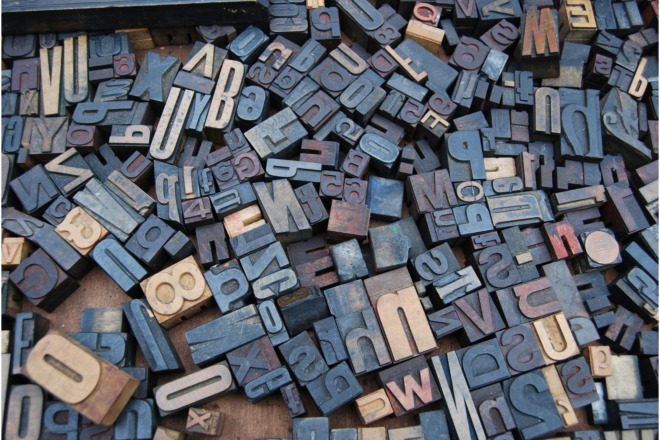Finding the perfect typography design tutorial takes your design to a new level. Typography is one of the most essential elements of any design. The average reader only reads about 20 percent of the text on a page, so you need to make a big impact with the words they do read. Choosing the right type allows you to grab the reader’s attention and make an impression with a headline, logo or other text you offset from the rest of the page.
However, you have to find just the right typography to get across the message you want. Whether you plan to design the type yourself, or you want a better understanding of which type to use where and when, design tutorials are a good investment of your time and resources.
We sorted through the many choices available for a possible typography design tutorial and narrowed the selection down to the top 13.
Jump to: Introduction to Typography | Create Graffiti Effect in Photoshop | Typography Terms | Type Art | Match Fonts | Hand-Lettering for Beginners | Typography Basics | Easy Vintage Text Effects | How to Use a Brush Pen for Hand-Lettering | Create Isometric Typography | How to Digitize Hand-Lettering | Get a Paper-Cut Look | Make Layered Floral Typography
1. Introduction to Typography
Grant Adam’s typography design tutorial tops our list because it delves into the basics of typography, giving you a good base to build upon. Adams is a lecturer at Diablo Valley College in Pleasant Hill, Calif.
He talks about how to place text within Adobe InDesign and create styles to save time. The beginning of the video is for his students taking the particular class he’s recording. If you want to skip past the first couple of minutes, you won’t miss anything. The valuable content of the lecture starts at the 2:25 mark.
This YouTube video is completely free to access, which is a nice perk. It’s like sitting in on a college class without having to pay the high costs to enroll. If you follow Adam’s YouTube channel, you can access additional tutorials on a variety of design topics.
2. Create Graffiti Effect in Photoshop
If you’d like to learn some specific typography design skills, this tutorial delves into creating a graffiti-like effect using Photoshop. The course is titled How to Create a Graffiti Effect in Adobe Photoshop.
The tutorial shows how to take a photo and make some aspects of it pop by adding graffiti-style elements. While the tutorial shows a variety of images, you can use the process for type. The basics of a brick wall with graffiti on top are easy to apply to logos, ads and other elements you’ll use in design. You’ll learn the basics of manipulating Photoshop to create something unique.
This tutorial is free, but envatotuts+ offers a variety of courses and e-books that delve deeper into topics such as typography.
3. Typography Terms
Does the above all sound like Greek to you? If you’re feeling a bit lost, you may want to take a step back and learn some of the basic terms involved with typography. Once you know the terms, it is easier to read a tutorial that describes a series of steps to achieve a desired result, because you’ll better understand what the instructor is talking about.
Canva has a typography tutorial titled “Terms, Tips and Tricks” by Poppie Pack. The writer starts with elementary terms, such as font versus typeface, size and weight. She then goes into more advanced topics, like ascender or descender. The tutorial itself — along with a basic use of Canva — is free, but if you want to use the professional features of Canva, you’ll need to pay for them.
4. Type Art
One interesting trend in typography design is type art. DigitalArts has a free typography design tutorial on this specific topic. The tutorial is for those using Adobe Illustrator and Photoshop. The tutorial goes into the basics of good design, even when it comes to type art.
By focusing on the basics, it is much easier to add in advanced elements later. For example, type art is sometimes difficult to read, so the tutorial addresses ways you can avoid that problem. This tutorial is free to read.
5. Match Fonts
What about those times when a client asks you to match the type in a given image and use it in a new design? Finding just the right type to match that image isn’t always an easy task. There are thousands of available fonts. It is almost impossible to know what font another designer used based on the look of the font alone, although you can make a good guess.
Fortunately, if you use Photoshop CC, you can use the “match font” feature to identify a font, then find one so similar no one will ever know the fonts are slightly different.
The video tutorial appears on Photoshop Training Channel’s YouTube profile, and it is free to watch.
6. Hand-Lettering for Beginners
Are you interested in learning hand-lettering? This tutorial starts at the beginning, assuming you don’t know much, if anything, about hand-lettering fonts. The tutorial includes 13 videos and runs a total of almost two hours. Expect to learn information such as what tools you need to create hand-lettered fonts, the basics of hand-drawn letters and insider tips.
The instructor is Mary Kate McDevitt, and she offers this and other design courses on Skillshare. You can sign up for a free one-month trial to give the course a try. There are other free courses on the site, but if you want full access to more than 200,000 courses, you’ll need to sign up for their premium account at $15 per month. You can also pay annually and reduce that cost to $8.25 per month.
7. Typography Basics
This beginning graphic tutorial by GCFLearnFree.org discusses the basics of typography and how you can find it everywhere — even on street signs. If you need a fundamental understanding of the terms and methods of typography, this video gets you started. The video goes into the basics of types of fonts, such as serif and sans serif fonts and where each kind of typography appears. The tutorial also delves into emerging technologies and how different fonts work with mobile devices or computers.
You’ll also learn about what fonts you should avoid, and dig into topics such as type hierarchy, tracking and kerning. Once you’ve completed the first tutorial, you can browse their other selections of learning videos on all types of graphic design topics, including how to use color and the best layout and composition for different designs.
8. Easy Vintage Text Effects
Some projects call for a vintage look to your typography design. Fortunately, there are some simple ways of adding a vintage look to your text without spending untold hours developing a new hand-drawn font. In the tutorial Three Easy Vintage Text Effects to Add Retro Charm to Your Designs, Grace Fussell delves into three simple effects you can add to your headings to give them a letterpress look.
By using Adobe InDesign and a texture overlay image, you’ll wind up with a type that is as unique as your project. Fussell shares three different methods to achieve an aged appearance, but then she also pulls out exactly how to use the rectangle tool and the color settings that will give you the look you’re going for.
The tutorial offers clear examples of what the finished font will look like, and then goes step-by-step into the process to create that look.
9. How to Use a Brush Pen for Hand-Lettering
Hand-lettering gives you a unique type no one else has. This approach is ideal for a logo or headline on any online or offline publication. However, learning how to use the tools of the trade can be difficult. Fortunately, Will Paterson’s Hand Lettering Tutorial: How to Use a Brush Pen goes into the details of how to perfect this technique.
Paterson is a logo designer who uses brush pens to get unique typography. The video shares the basics about brush lettering, but Paterson also has a more detailed course for a fee if you want to delve even deeper. In the video, Paterson shows the tools he uses and gives you some information on what each pen does and the look the pen creates.
He shows how to make some sections of the type thicker and some thinner, and which pen to use for which effect. He also shares some tips on how to identify a letter part and uses boxes to show the size of different fonts and why different fonts connect how and where they do. The free tutorial should give anyone wanting to try hand-lettering a solid base for how to create hand-lettered type.
10. Create Isometric Typography
Isometric shapes are currently a popular trend. They give any design a three-dimensional look and make the shapes pop off the page. They also work well in the higher levels of type hierarchy. Creating isometric type requires a bit of a different technique than some other digital fonts.
In the tutorial titled How to Use Illustrator to Create Isometric Typography, Alex Clem talks about how to create isometric letters using Illustrator, going into the Bevel and Extrude effects. He takes users step by step into creating simple isometric shapes in Illustrator, showing the settings and tools you’d use via a variety of screenshots. He then moves into turning text into an isometric shape.
11. How to Digitize Hand-Lettering
Sean McCabe explains How to Digitize Hand-Lettering in his YouTube tutorial on going from Sketch to Vector. He first shows the process he has developed, and how he takes a hand-drawn image and moves it to the computer.
He starts in Photoshop and shows you how to tidy the graphic and align everything, then moves to Illustrator for a walk-through of how to vector the image. Finally, McCabe talks about cleaning up the final type and preparing digital files for print. He even goes into some tips on Pantone colors to get the exact look you want.
12. Get a Paper-Cut Look
Do you want a handcrafted, paper-cut look to your type? Grace Fussell brings us another tutorial on typography, sharing her creativity and insight as a digital artist in her tutorial, Paper Cut-Out Tutorial: Give Your Typography a Digital Craft Look. You’ll need Adobe InDesign for this lesson, but you’ll also use Illustrator for vectors. Fussell shares the specific images she used for her design if you want to repeat what she’s done, but she also explains you can use any stock vector font in the EPS version.
Fussell goes through the steps needed to create the paper-cut look, starting with the layers you need to use. She then moves through each layer, explaining the color settings and swatches you’ll need to use, and the tools that provide the finished look, such as the settings for different mode effects. You’ll add the finishing touches to the design with a gradient over the top.
13. Make Layered Floral Typography
Expand your typography skills with a more artistic approach. This tutorial, How to Create a Layered Floral Typography Text Effect in Adobe Photoshop, goes through the steps to make type with a floral background. This trend of taking gorgeous bouquets and layering bold lettering on top works well for logos for flower shops, as well as wedding websites or invitations.
The tutorial goes into how to enhance the color of the flowers on a white background using Photoshop. Next, you’ll learn how to add the text and the best size and font types. Not every font will show up on a floral background, so you’ll need something with thick letters. You can then add finishes such as a vine creeping between the letters or a flower poking out here and there.
Typography Design Tutorials
There are hundreds of typography design tutorials online. You can find a tutorial for almost any type of typography design you’d like to learn. However, the 13 above are a nice mix of different types of typography design. Start with these to build your skills, then move on from there. Before you know it, you’ll be an expert typographer at the top of your field.
About The Author
Eleanor Hecks is the Editor-in-Chief of Designerly Magazine, an online publication dedicated to providing in-depth content from the design and marketing industries. When she's not designing or writing code, you can find her exploring the outdoors with her husband and dog in their RV, burning calories at a local Zumba class, or curled up with a good book with her cats Gem and Cali.
You can find more of Eleanor's work at www.eleanorhecks.com.


